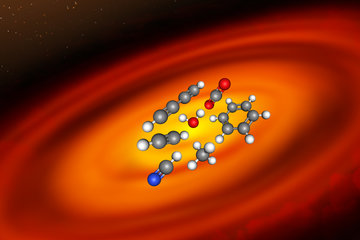Life on distant moons
Liquid water is one of the most important ingredients for the emergence of life as we know it on Earth. Researchers of the ORIGINS Cluster and the Max Planck Institute for Extraterrestrial Physics from the fields of astrophysics, astrochemistry and biochemistry have now determined the necessary properties that allow moons around free-floating planets to retain liquid water for a sufficiently long time and thus enable life.
For the emergence of life on Earth, liquid water is a crucial component. Although only one planet is known so far to have given rise to life, the scientific world assumes that elsewhere, too, the presence of liquid water plays a pivotal role in the chemical evolution that can lead to the emergence of life. In and outside our solar system, the habitable zone defines an annular region around the central star in which planets are neither too hot nor too cold for liquid water. Moons can also be habitable - even if they belong to planets beyond the habitable zone. In that case, however, they must have a heat source other than a central star, such as changing tidal forces. For example, thanks to tidal heating, an ocean of liquid water is hidden beneath the ice crust of Saturn's moon Enceladus.
Moons around free-floating planets can be habitable

The discovery of dozens of free-flying planets (FFPs) in our galaxy has changed understanding of the early evolution of planetary systems and theories of planet formation. These lonely wanderers were probably ejected from their planetary systems by dynamic instabilities and thus no longer have a parent star. However, if they have moons in tight orbits, they can gravitationally bind them. This works best for Jupiter-like planets with Earth-sized moons. In this way, new, unexpected places emerge where life could form.
In a previous study of liquid water on moons of starless planets, the researchers demonstrated that Earth-sized moons around Jupiter-like planets may indeed have liquid water. “We modelled this environment and found that, under specific conditions and assuming stable orbital parameters over time, liquid water can be formed on the surface of the exomoon,” explains Tommaso Grassi from the Max Planck Institute for Extraterrestrial Physics. “While the final amount of water for an Earth-mass exomoon is smaller than the amount of water in Earth oceans, it would be enough to host the potential development of primordial life.”
Local wet-dry cycles (evaporation and condensation), as recently shown in a study of the first stages in the evolution by ORIGINS scientists, provide the necessary chemical complexity that could promote the accumulation of molecules and the polymerization of RNA.
Astrophysics meets biochemistry
The orbit of exomoons around FFPs becomes less eccentric and more circular over time. This reduces the tidal forces and thus the heating efficiency. In a unique collaboration, the team developed a new, realistic model that can calculate the evolution of lunar orbits over long time scales. These are time scales of several billion years, as required for the evolution of life.
“In this way, we found out that exomoons with small orbital radii not only have the best chance of surviving their planet's ejection from its planetary system, but also remain eccentric for the longest period of time,” says PhD student Guilia Roccetti (ESO), the first author of the paper. “They can thus optimally produce tidal heat.” In addition, dense atmospheres favour the preservation of liquid water. Thus, Earth-sized moons with Venus-like atmospheres with close-in orbits around their orphan planets are good candidates for habitable worlds.












